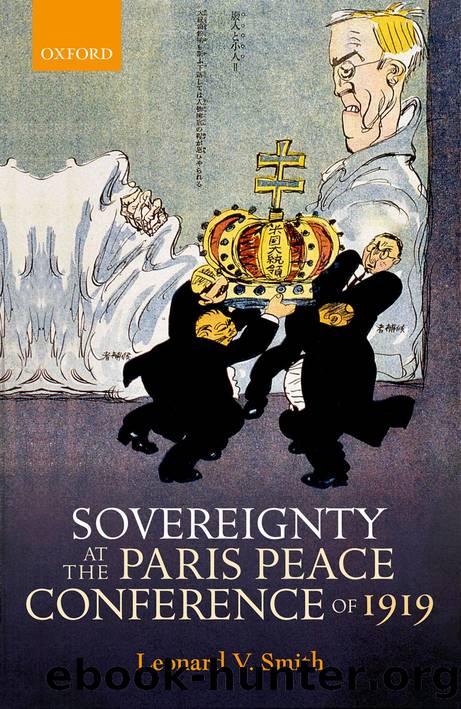Sovereignty at the Paris Peace Conference Of 1919 by Smith Leonard V.;

Author:Smith, Leonard V.; [Smith, Leonard V.]
Language: eng
Format: epub
Publisher: Oxford University Press, Incorporated
Published: 2018-01-30T00:00:00+00:00
4
The âUnmixingâ of Peoples
Implicating âthe peopleâ in their own identification had vastly complicated territoriality at the Paris Peace Conference. The Supreme Councilâs claim of sovereignty over borders in the lands of the defeated multinational empires rested, at least in part, on its claim to be building a more democratic world. Preserving that sovereignty remained a preoccupation of the Council. Someone, after all, still needed to figure out who âthe peopleâ actually were. The conference had two broad choicesâadjusting boundaries to suit peoples, or adjusting peoples to suit boundaries. In a nutshell, the Council turned to the latter when and where it could not accomplish the former.
This chapter examines four varieties of population policiesâplebiscites, minority treaties, racial classification of mandate populations, and âpopulation exchanges.â All these policies sought to identify peoples. Under plebiscites, peoples could supposedly âself-determine.â But every decision on where to hold a plebiscite also constituted a territorial decision, which demarcated borders within which voters would be presented with a choice. Plebiscites also provided only preselected categories of identity. Minority treaties bracketed certain aspects of identity, notably religion and ethnicity, and placed them under supranational protection through the League of Nations. But this meant politically significant differentiations among citizens within successor states. For this reason, all of the successor states ferociously opposed the minority treaties. These treaties also produced a hierarchy of states, in which some states had their national sovereignty circumscribed by international protections, and others not.
The sovereignty of the conference over âunmixingâ peoples had two particularly blunt manifestations. The system of âA-,â âB-,â and âC-â class mandates created a racial categorization of peoples pure and simple. But these identities followed the requirements of imperial politics. Peoples were either more or less âcivilizedâ and either more or less suitable for eventual independence depending on how vigorously the mandatory power had sought direct annexation. Population exchanges were the most brutal of population policies. They imposed ânationalâ identities with no input from the affected populations, and were carried out by physical force or the threat thereof. Indeed, for that reason, the conference went to some trouble to keep population exchanges at armâs length. But in the end, population exchanges simply amounted to ânational self-determinationâ carried to one logical conclusion. The âselfâ by that point had little to do with choices made by the peoples in question.
Download
This site does not store any files on its server. We only index and link to content provided by other sites. Please contact the content providers to delete copyright contents if any and email us, we'll remove relevant links or contents immediately.
Verus Israel: Study of the Relations Between Christians and Jews in the Roman Empire, AD 135-425 by Marcel Simon(552)
Infocracy by Byung-Chul Han(541)
Caesar Rules: The Emperor in the Changing Roman World (c. 50 BC â AD 565) by Olivier Hekster(530)
Europe, Strategy and Armed Forces by Sven Biscop Jo Coelmont(477)
Banned in the U.S.A. : A Reference Guide to Book Censorship in Schools and Public Libraries by Herbert N. Foerstel(447)
Reading Colonial Japan by Mason Michele;Lee Helen;(444)
The Roman World 44 BC-AD 180 by Martin Goodman(437)
Give Me Liberty, Seventh Edition by Foner Eric & DuVal Kathleen & McGirr Lisa(436)
DS001-THE MAN OF BRONZE by J.R.A(423)
The Dangerous Life and Ideas of Diogenes the Cynic by Jean-Manuel Roubineau(417)
The Oxford History of World War II by Richard Overy(414)
Introducing Christian Ethics by Samuel Wells and Ben Quash with Rebekah Eklund(412)
american english file 1 student book 3rd edition by Unknown(412)
Imperial Rome AD 193 - 284 by Ando Clifford(409)
Basic japanese A grammar and workbook by Unknown(392)
Literary Mathematics by Michael Gavin;(373)
Language Hacking Mandarin by Benny Lewis & Dr. Licheng Gu(352)
How to Reach the 9.0 in IELTS Academic Reading by IELTS Medical(333)
The Oxford History of the Renaissance by Campbell Gordon;(332)
